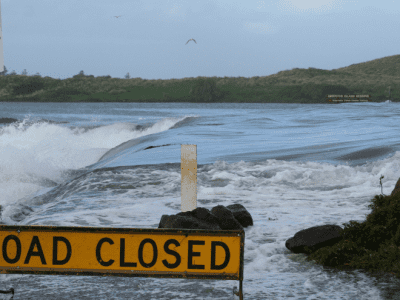Recent federal coastal initiatives – February 2022
In recent weeks there have been two initiatives that place the Australian Government back into coastal management in a direct way. While these are most welcome, it will be important to monitor how they are implemented around the nation given complexities of coastal governance and the “wicked” nature of problems facing coastal managers at state and local government levels.
For many years there has been pressure on the Australian Government to establish a national disaster insurance scheme of some sort. My first involvement goes back to 1976 including recommendations that emerged from an Academy of Science symposium. Successive governments on advice from Treasury have shied away from doing anything other than help pick up some of the costs post disaster. Well things have changed especially after determined lobbying by politicians in cyclone-affected areas in north Queensland. The outcome is now before Parliament as “A Bill for an Act to amend the Terrorism Insurance Act 2003 in order to establish a cyclone and related damage reinsurance pool operated by the Australian Reinsurance Pool Corporation”.
I resist the temptation to go into detail as to my involvement with Treasury and DAWE on this legislation. Two submissions were made which I am told will be posted on Treasury website once the Bill is enacted. At the moment it has been debated in the House of Representatives (second reading speech by Assistant Treasurer 9/2/22, debated on 17/2/22). Labor supported the Bill; it now goes to the Senate. Pressure on government to do something about mounting premiums being charged by insurers in northern Australia drove the government to find a way to improve accessibility and affordability of insurance for households and small businesses in cyclone-prone areas. Government owned properties including those of local councils are not eligible for coverage.
The reinsurance pool is backed by a Commonwealth guarantee of $10b. It will cover damages caused by a cyclone as declared by the Bureau of Meteorology arising from wind, rain, rainwater run-off, storm surge and riverine flooding, where these hazards are covered under the policyholder’s insurance policy. Cyclones are defined generically (s 3A of Regulations) and it is up to the Bureau to determine that a “cyclone” exists and is likely to affect any part of Australia. The legislation is structured in such a way as to offer incentives to reduce risk. Publication of an annual report by the Corporation aims to provide scrutiny of premium adequacy and risk-preparedness activities according to the Assistant Treasurer in his second reading speech.
There are many questions on how this legislation will work. The news release on 22/2/22 by the Insurance Council of Australia on the need for more federal and state government investment in making the nation more resilient to worsening extreme weather highlights difficulties insurers face in meeting challenges from cyclones. This legislation will require insurers to take steps that may prove hard to implement especially with respect to storm surge and related actions of the sea which many policies do not cover. Whether governments will make life easier for insurers by investing in mitigation infrastructure projects without adverse maladaptive consequences remains to be seen.
The second initiative is the announcement on 13/2/22 by Senator Bridget McKenzie on behalf of the Australian Government of $50m from the Emergency Response Fund for coastal and estuarine resilience. Previously this fund had been used for national flood mitigation infrastructure projects over 2 years 2020-21. What is important here is recognition by the federal government that support is needed to protect communities from natural disasters including storm surges and coastal inundation. I was delighted to see estuaries explicitly included in the allocation.
The “Coastal and Estuarine Risk Mitigation Program” as it is called, provides funding to state and territory governments, not direct to local governments. Areas of focus include (1) priority national coastal hazard risk mitigation measures such as “grey, blue and green infrastructure”; (2) planning including local and regional risk assessments and mapping, preparation of coastal management programs; and (3) monitoring of the coastal zone over time to help with future action to manage coastal hazards. Guidelines for applications are being prepared in consultation with the states in March.
This renewed federal interest is welcome as it brings opportunities for strategic investment in coastal management where the Australian Government can be seen to be involved. It reminds me of the Coasts and Clean Seas Program of 20 years ago under Senator Hill although that program had components that directly targeted local government. However, there will be challenges in the way funds are allocated, committed, and monitored. One can only hope that over time the Emergency Response Fund will remain a source of funds that will benefit sustainable coastal management.
Bruce Thom
Words by Prof Bruce Thom. Please respect the author’s thoughts and reference appropriately: (c) ACS, 2022. For correspondence about this blog post please email austcoastsoc@gmail.com
#210


 Resourceful ‘lucky’ country
Resourceful ‘lucky’ country